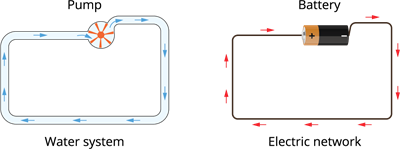
PUMPA - SMART LEARNING
எங்கள் ஆசிரியர்களுடன் 1-ஆன்-1 ஆலோசனை நேரத்தைப் பெறுங்கள். டாப்பர் ஆவதற்கு நாங்கள் பயிற்சி அளிப்போம்
Book Free DemoConsider connecting two ends of a water pipe. Even though the tube is filled with water, the water will not move on its own. Imagine that you are inserting a pump between the two pipes to push the water through the tube. This movement/flow of water can be used to generate work.

Analogy between battery and water pump
A water-wheel is placed in the middle of the water flow to rotate. This rotation helps to run machinery.

Water-wheel
Similarly, a circular copper wire is filled with free electrons. However, the electrons are not flowing in any one particular direction. Hence, some amount of force is required to push the electrons in a direction.
Work done is the amount of electrical energy converted into other forms of energy. It is measured in joule.
Electric cells and other electrical energy sources work like pumps, forcing charges through a wire or conductor. The electromotive force (e.m.f) enables the pumping action of the electrical energy source. The e.m.f is denoted by \(ε\) (epsilon).
The electromotive force (e.m.f) of an electrical energy source is the work done (\(W\)) by the source in driving a unit charge (\(q\)) around the complete circuit.
The formula is,
Where \(ε\) is the electromotive force, \(W\) is the work done, and \(q\) is the charge.
Unit
The SI unit of e.m.f is joules per coulomb (\(JC^{-1}\)) or volt (\(V\)).
The e.m.f of an electrical energy source is one volt if one joule of work is done by the source to drive one coulomb of charge completely around the circuit.